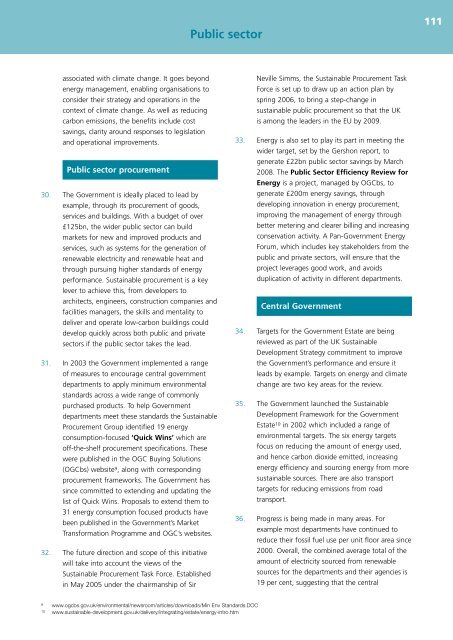UK Climate Change Programme 2006 - JNCC - Defra
UK Climate Change Programme 2006 - JNCC - Defra
UK Climate Change Programme 2006 - JNCC - Defra
You also want an ePaper? Increase the reach of your titles
YUMPU automatically turns print PDFs into web optimized ePapers that Google loves.
Public sector<br />
111<br />
associated with climate change. It goes beyond<br />
energy management, enabling organisations to<br />
consider their strategy and operations in the<br />
context of climate change. As well as reducing<br />
carbon emissions, the benefits include cost<br />
savings, clarity around responses to legislation<br />
and operational improvements.<br />
Public sector procurement<br />
30. The Government is ideally placed to lead by<br />
example, through its procurement of goods,<br />
services and buildings. With a budget of over<br />
£125bn, the wider public sector can build<br />
markets for new and improved products and<br />
services, such as systems for the generation of<br />
renewable electricity and renewable heat and<br />
through pursuing higher standards of energy<br />
performance. Sustainable procurement is a key<br />
lever to achieve this, from developers to<br />
architects, engineers, construction companies and<br />
facilities managers, the skills and mentality to<br />
deliver and operate low-carbon buildings could<br />
develop quickly across both public and private<br />
sectors if the public sector takes the lead.<br />
31. In 2003 the Government implemented a range<br />
of measures to encourage central government<br />
departments to apply minimum environmental<br />
standards across a wide range of commonly<br />
purchased products. To help Government<br />
departments meet these standards the Sustainable<br />
Procurement Group identified 19 energy<br />
consumption-focused ‘Quick Wins’ which are<br />
off-the-shelf procurement specifications. These<br />
were published in the OGC Buying Solutions<br />
(OGCbs) website 9 , along with corresponding<br />
procurement frameworks. The Government has<br />
since committed to extending and updating the<br />
list of Quick Wins. Proposals to extend them to<br />
31 energy consumption focused products have<br />
been published in the Government’s Market<br />
Transformation <strong>Programme</strong> and OGC’s websites.<br />
32. The future direction and scope of this initiative<br />
will take into account the views of the<br />
Sustainable Procurement Task Force. Established<br />
in May 2005 under the chairmanship of Sir<br />
Neville Simms, the Sustainable Procurement Task<br />
Force is set up to draw up an action plan by<br />
spring <strong>2006</strong>, to bring a step-change in<br />
sustainable public procurement so that the <strong>UK</strong><br />
is among the leaders in the EU by 2009.<br />
33. Energy is also set to play its part in meeting the<br />
wider target, set by the Gershon report, to<br />
generate £22bn public sector savings by March<br />
2008. The Public Sector Efficiency Review for<br />
Energy is a project, managed by OGCbs, to<br />
generate £200m energy savings, through<br />
developing innovation in energy procurement,<br />
improving the management of energy through<br />
better metering and clearer billing and increasing<br />
conservation activity. A Pan-Government Energy<br />
Forum, which includes key stakeholders from the<br />
public and private sectors, will ensure that the<br />
project leverages good work, and avoids<br />
duplication of activity in different departments.<br />
Central Government<br />
34. Targets for the Government Estate are being<br />
reviewed as part of the <strong>UK</strong> Sustainable<br />
Development Strategy commitment to improve<br />
the Government’s performance and ensure it<br />
leads by example. Targets on energy and climate<br />
change are two key areas for the review.<br />
35. The Government launched the Sustainable<br />
Development Framework for the Government<br />
Estate 10 in 2002 which included a range of<br />
environmental targets. The six energy targets<br />
focus on reducing the amount of energy used,<br />
and hence carbon dioxide emitted, increasing<br />
energy efficiency and sourcing energy from more<br />
sustainable sources. There are also transport<br />
targets for reducing emissions from road<br />
transport.<br />
36. Progress is being made in many areas. For<br />
example most departments have continued to<br />
reduce their fossil fuel use per unit floor area since<br />
2000. Overall, the combined average total of the<br />
amount of electricity sourced from renewable<br />
sources for the departments and their agencies is<br />
19 per cent, suggesting that the central<br />
9 www.ogcbs.gov.uk/environmental/newsroom/articles/downloads/Min Env Standards.DOC<br />
10 www.sustainable-development.gov.uk/delivery/integrating/estate/energy-intro.htm
















